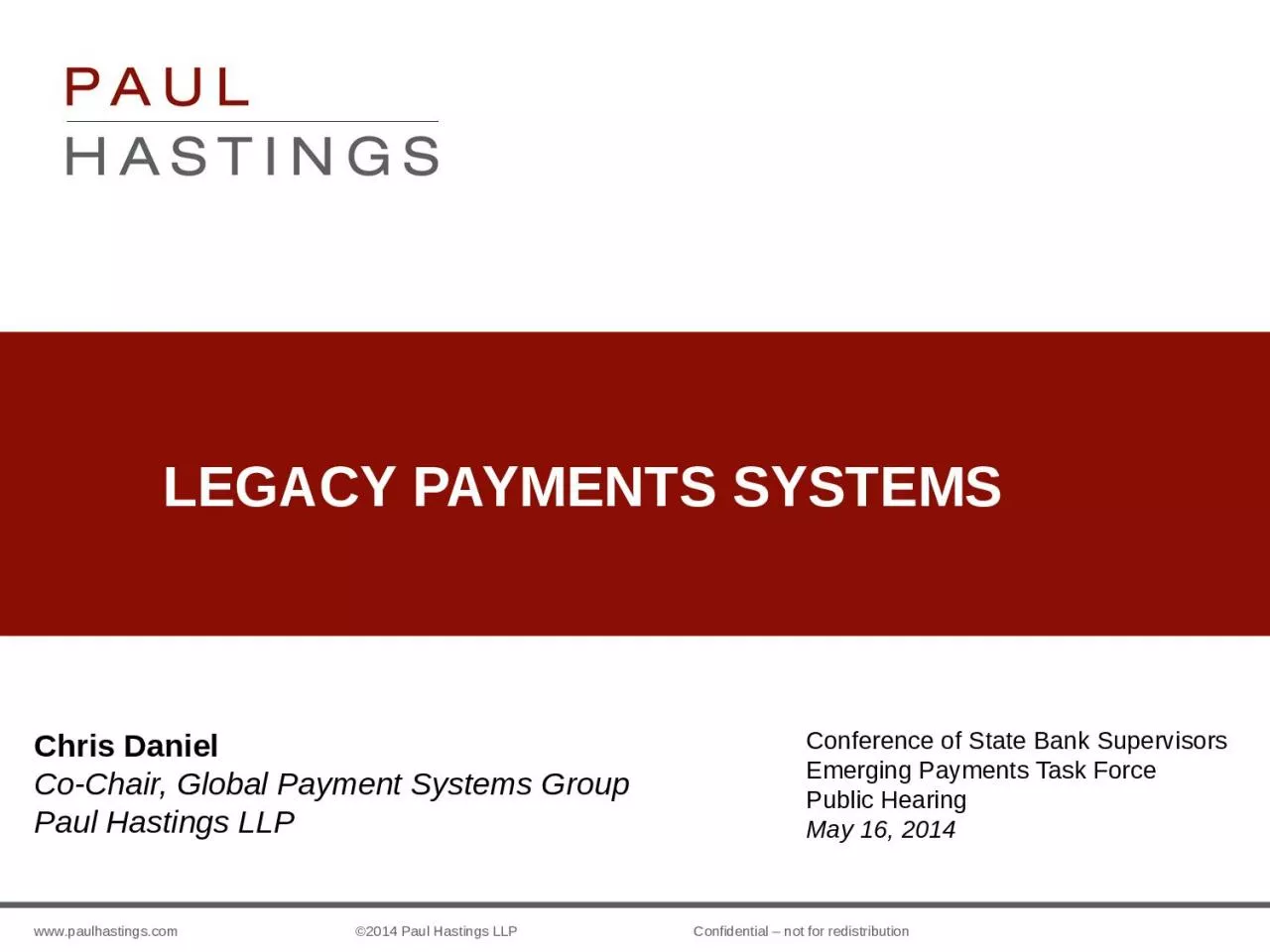

CoChair Global Payment Systems Group Paul Hastings LLP Conference of State Bank Supervisors Emerging Payments Task Force Public Hearing May 16 2014 Overview A History of Currency in the United States ID: 1029741
Download Presentation The PPT/PDF document "Legacy Payments Systems Chris Daniel" is the property of its rightful owner. Permission is granted to download and print the materials on this web site for personal, non-commercial use only, and to display it on your personal computer provided you do not modify the materials and that you retain all copyright notices contained in the materials. By downloading content from our website, you accept the terms of this agreement.
1. Legacy Payments SystemsChris DanielCo-Chair, Global Payment Systems GroupPaul Hastings LLPConference of State Bank Supervisors Emerging Payments Task Force Public HearingMay 16, 2014
2. OverviewA History of Currency in the United StatesThe M1 Money SupplyModern Payments SystemsOverviewOpen SystemFour Party Card NetworkThe Federal Reserve Payments StudyShared Attributes of Successful Payments SystemsPayments Systems – ExamplesCurrency and Technology
3. A History of Currency in the United States“For the first five generations of America’s independent history – from 1776 till the eve of World War I – a single question has vexed American politics and the American economy more persistently than any other. Political careers were made and broken on this question; political parties rose and fell. Great wealth rewarded those who answered it correctly; bankruptcy claimed those who got it wrong. No question touched more livelihoods and more lives more consistently, more intimately, more portentously. The question was the money question. In simplest form it asked: What constitutes money in the United States?”-David Wolman, The End of Money: Counterfeiters Preachers, Techies, Dreamers – and the Coming Cashless Society (2012).
4. A History of Currency in the United StatesColonial Currency (1565-1792)State Bank-Issued Notes(1836-1863)Civil War-Era Greenbacks(1862)Gold Standard Act(1900)Bretton Woods System(1944-1971)Bi-Metallism (Gold/Silver)
5. The M1 Money SupplyM1 Money Supply on October 13, 2008: $1,466.7 (billions)M1 Money Supply on April 28, 2014: $2,776.7 (billions)
6. Modern Payments SystemsOverviewPayments transfer value from one end party to another. A payments system defines how these value transfers are done and provides a framework of rules for users of the system. There are six core payments systems in the United States. Almost all other methods of payment (e.g., mobile telephone payments or online bill payments) rely on one or more of these core payments systems to actually transfer value between parties. These core payments systems are:Cash;The checking system;The credit card and charge card systems;The debit card systems;The Automated Clearing House system; andThe wire transfers systems. The various uses of payments can generally be categorized into six categories:Point of sale; Remote commerce;Bill payment; Person-to-person payment;Business-to-business payment; andIncome payment (e.g. payroll). Often, the various core payments systems will compete for market share within the six payment categories. For example, the use of checking for business-to-business payments is currently in decline. All of the electronic payments systems are now competing for the volumes in this category of payments.
7. Modern Payments Systems Cont. Open SystemClearingMechanismBankBankBankBankBankBankBankBankMerchantMerchantCustomerCustomer
8. Modern Payments Systems Cont. Four Party Card NetworkVisa/MasterCardAcquiring BankIssuing BankMerchantCardholder$Data
9. Modern Payments Systems Cont. Results from the 2013 Federal Reserve Payments StudyTotal number of non-cash payments in 2012: 122.8 billion, which is a 4.4 percent increase from 2009. Cards continue to increase their share of total non-cash payments. Cards significantly increased their share of total non-cash payments, from 43 percent in 2003 to 67 percent in 2012. The use of ACH grew more modestly during the same period (from 11 percent to 18 percent), while the use of checks fell sharply (from 46 percent to 15 percent). Debit card payments continue to outpace credit card payments in number of transactions. In 2012, there were 47 billion debit card payments and only 26.2 billion credit card payments. Compared with credit, debit, ACH and check, prepaid card payments increased at the fastest rate from 2009 to 2012 – 15.8 percent annually.
10. Shared Attributes of Successful Payments SystemsCommon Principles: Price stability;Thoughtful design with consideration of a nation’s monetary regime; Technical efficiency; Designed with access to credit in mind; Legal framework;Official oversight and supervision; and Central bank serving as the final settlement authority. Bruce J. Summers, The Payment System in a Market Economy, in The Payment System: Design, Management, and Supervision 1 (Bruce J. Summers ed., 1994). Two additional attributes: TrustRegulation of both the settlement system and end participants
11. Payments Systems - ExamplesThe Euro is the single currency currently shared by 18 of the European Union’s Member States. Initially introduced on January 1, 1999. The following countries have replaced their national currencies with the Euro:Belgium (Belgian franc)Portugal (escudo)Germany (Deutsche mark)Finland (markka)Ireland (Irish pound)Greece (drachma)Spain (peseta)Slovenia (tolar)France (franc)Cyprus (Cypriot pound)Italy (lira)Malta (Maltese lira)Luxembourg (Luxembourgish franc)Slovakia (koruna)The Netherlands (guilder)Estonia (kroon)Austria (schilling)Latvia (lats)Special Drawing Rights (“SDRs”) serve as a means of payment within the International Monetary Fund (“IMF”)SDRs are not currency or claims on the IMF. They are potential claims that can be exchanged for “freely usable currency” of IMF members. Freely usable currency is “a member’s currency that the IMF determines is widely used to make payments for international transactions and is widely traded in principal exchange markets.”SDRs may be used to repay loans to the IMF or as a payment of interest within the SDR department. Members may also voluntarily exchange their SDR holdings for freely useable currencies with other IMF members.
12. Currency and Technology